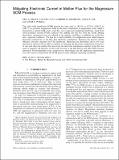| dc.contributor.author | Guan, Xiaofei | |
| dc.contributor.author | Gratz, Eric S. | |
| dc.contributor.author | Milshtein, Jarrod D. | |
| dc.contributor.author | Pal, Uday B. | |
| dc.contributor.author | Powell, Adam C. | |
| dc.contributor.author | Milshtein, Jarrod David | |
| dc.date.accessioned | 2016-12-16T21:05:43Z | |
| dc.date.available | 2016-12-16T21:05:43Z | |
| dc.date.issued | 2014-03 | |
| dc.date.submitted | 2013-11 | |
| dc.identifier.issn | 1073-5615 | |
| dc.identifier.issn | 1543-1916 | |
| dc.identifier.uri | http://hdl.handle.net/1721.1/105861 | |
| dc.description.abstract | The solid oxide membrane (SOM) process has been used at 1423 K to 1473 K (1150 °C to 1200 °C) to produce magnesium metal by the direct electrolysis of magnesium oxide. MgO is dissolved in a molten MgF[subscript 2]-CaF[subscript 2] ionic flux. An oxygen-ion-conducting membrane, made from yttria-stabilized zirconia (YSZ), separates the cathode and the flux from the anode. During electrolysis, magnesium ions are reduced at the cathode, and Mg[subscript (g)] is bubbled out of the flux into a separate condenser. The flux has a small solubility for magnesium metal which imparts electronic conductivity to the flux. The electronic conductivity decreases the process current efficiency and also degrades the YSZ membrane. Operating the electrolysis cell at low total pressures is shown to be an effective method of reducing the electronic conductivity of the flux. A two steel electrode method for measuring the electronic transference number in the flux was used to quantify the fraction of electronic current in the flux before and after SOM process operation. Potentiodynamic scans, potentiostatic electrolyses, and AC impedance spectroscopy were also used to characterize the SOM process under different operating conditions. | en_US |
| dc.description.sponsorship | National Science Foundation (U.S.) (Grant No. 102663) | en_US |
| dc.description.sponsorship | United States. Dept. of Energy (Grant No. DE-EE0005547) | en_US |
| dc.publisher | Springer US | en_US |
| dc.relation.isversionof | http://dx.doi.org/10.1007/s11663-014-0060-9 | en_US |
| dc.rights | Article is made available in accordance with the publisher's policy and may be subject to US copyright law. Please refer to the publisher's site for terms of use. | en_US |
| dc.source | Springer US | en_US |
| dc.title | Mitigating Electronic Current in Molten Flux for the Magnesium SOM Process | en_US |
| dc.type | Article | en_US |
| dc.identifier.citation | Gratz, Eric S., Xiaofei Guan, Jarrod D. Milshtein, Uday B. Pal, and Adam C. Powell. “Mitigating Electronic Current in Molten Flux for the Magnesium SOM Process.” Metallurgical and Materials Transactions B 45, no. 4 (March 29, 2014): 1325–1336. | en_US |
| dc.contributor.department | Massachusetts Institute of Technology. Department of Materials Science and Engineering | en_US |
| dc.contributor.mitauthor | Milshtein, Jarrod David | |
| dc.relation.journal | Metallurgical and Materials Transactions B | en_US |
| dc.eprint.version | Author's final manuscript | en_US |
| dc.type.uri | http://purl.org/eprint/type/JournalArticle | en_US |
| eprint.status | http://purl.org/eprint/status/PeerReviewed | en_US |
| dc.date.updated | 2016-08-18T15:45:38Z | |
| dc.language.rfc3066 | en | |
| dc.rights.holder | The Minerals, Metals & Materials Society and ASM International | |
| dspace.orderedauthors | Gratz, Eric S.; Guan, Xiaofei; Milshtein, Jarrod D.; Pal, Uday B.; Powell, Adam C. | en_US |
| dspace.embargo.terms | N | en |
| dc.identifier.orcid | https://orcid.org/0000-0001-8322-5106 | |
| mit.license | PUBLISHER_POLICY | en_US |
